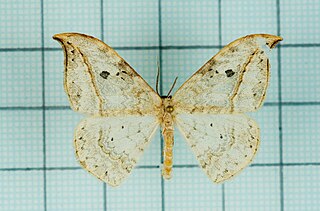
Pyraustinae is a large subfamily of the lepidopteran family Crambidae, the crambid snout moths. It currently includes over 1,400 species; most of them tropical but some found in temperate regions including both North America and Europe.
Acropentias is a genus of moths of the family Crambidae.
Staphylinochrous euryphaea is a species of moth of the Anomoeotidae family. It is found in Cameroon and Ghana.

Drepana pallida is a moth of the family Drepanidae first described by Frederic Moore in 1879. It is found in south-east Asia, from northern India and Myanmar to Vietnam, mainland China and Taiwan.

Europlema desistaria is a species of moth of the family Uraniidae first described by Francis Walker in 1861. It is found in India, Sri Lanka, Myanmar, Thailand, Taiwan, Borneo, Sulawesi, Flores and Queensland.
Margarosticha gaudialis is a moth in the family Crambidae. It was described by George Hampson in 1917. It is found in Papua New Guinea.
Calamotropha oculalis is a moth in the family Crambidae. It was described by Samuel Constantinus Snellen van Vollenhoven in 1893. It is found on Java and Sri Lanka.
Calamotropha punctivenellus is a moth in the family Crambidae. It was described by George Hampson in 1896. It is found in Sri Lanka.
Patissa tinctalis is a moth in the family Crambidae. It was described by George Hampson in 1919. It is found in Australia, where it has been recorded from Queensland.
Patissa fulvipunctalis is a moth in the family Crambidae. It was described by George Hampson in 1919. It is found in Uganda.
Syllepte tetrathyralis is a moth in the family Crambidae. It was described by George Hampson in 1912. It is found in New Guinea.
Syllepte xylocraspis is a moth in the family Crambidae. It was described by George Hampson in 1912. It is found in South Africa.
Ambia cymophoralis is a moth in the family Crambidae described by George Hampson in 1917. It is found on St Aignan Island in the Louisiade Archipelago of Papua New Guinea.
Ambia fulvicolor is a moth in the family Crambidae. It was described by George Hampson in 1917 and it is found in New Guinea.

Nordstromia bicostata is a moth in the family Drepanidae. It was described by George Hampson in 1912. It is found in Sikkim in India, Sichuan in China, Nepal and northern Myanmar.
Doratopteryx steniptera is a moth in the Himantopteridae family. It was described by George Hampson in 1919. It is found in Tanzania.
Semioptila dolicholoba is a moth in the Himantopteridae family. It was described by George Hampson in 1920. It is found in Malawi.
Semioptila latifulva is a moth in the Himantopteridae family. It was described by George Hampson in 1920. It is found in Tanzania.
Semioptila trogoloba is a moth in the Himantopteridae family. It was described by George Hampson in 1920. It is found in Malawi and Mozambique.

Semioptila flavidiscata is a moth in the Himantopteridae family. It was described by George Hampson in 1910. It is found in South Africa, Zambia and Zimbabwe.




